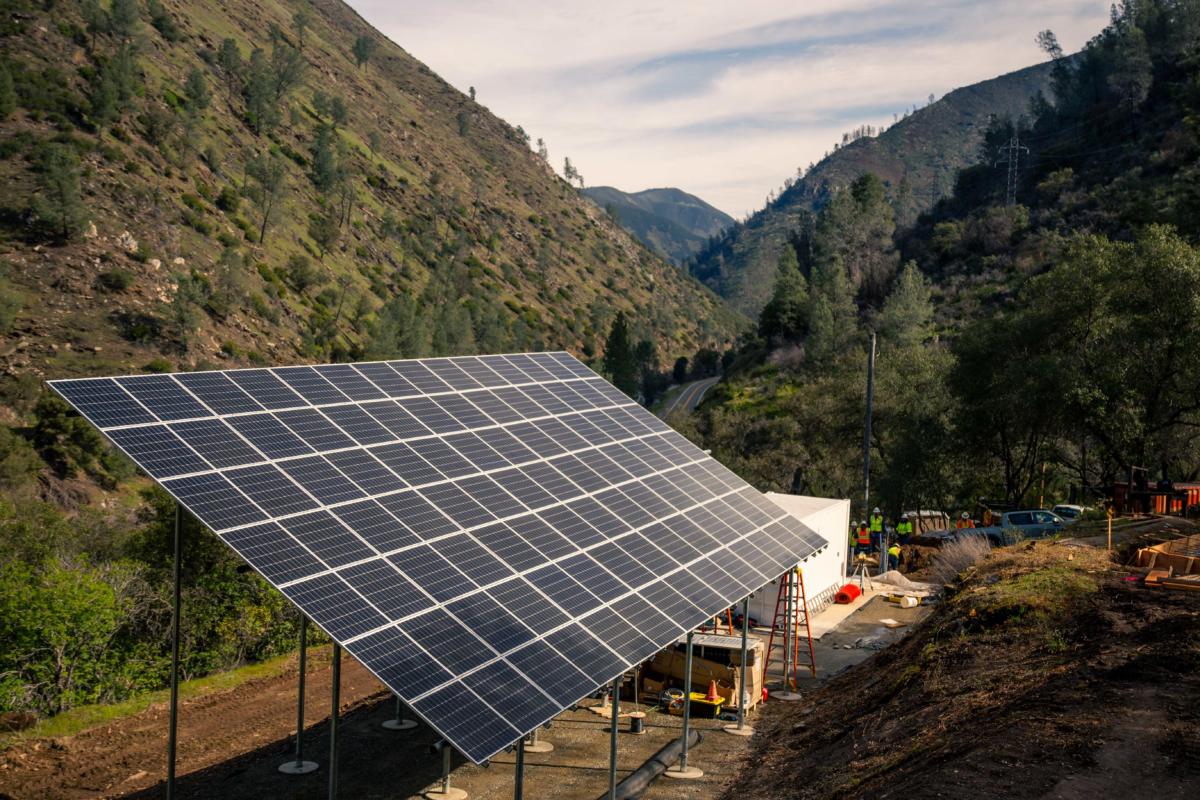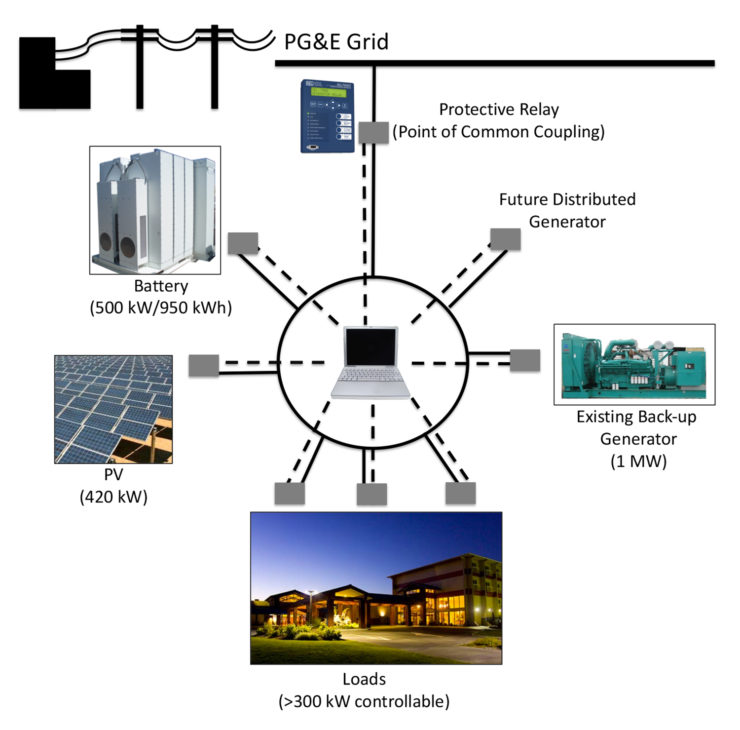
On 2019-10-07, Briceburg in Mariposa County, near Yosemite National Park, in California, lost the only power line connecting it to the electrical grid in a wildfire that devoured over 20 square kilometers. The system, owned by Pacific Gas & Electric (PG&E), but installed and developed by BoxPower, provides Briceburg with a self-reliant, stand-alone power system made of solar panels in an array, batteries and a backup generator. It began operating 2021-06-01.
The solar array consisting of 36.5 kW of photovoltaic solar panels, a 69.12 kWh lithium ferro phosphate battery bank. This can provide 27.2 kW of continuous power output with a surge capacity of up to 48 kW. The system has two integrated 35 kVA propane prime power generators and a fire suppression system to protect the hardware. PG&E and BoxPower will be able to monitor/ control the system via satellite.
While wildfires in 2019, forced PG&E to file for bankruptcy in 2019, the main reason for using this technology is to improve energy resilience in California as extreme heat, drought and wildfires devastate the American west. Human-based climate change is causing blackouts and disrupting power supply. Wind-storms led utilities to deliberately shut off power to large areas of California to keep high-voltage transmission lines from starting fires. Then 2020-08-14 & 15, an oppressive heat wave forced the California Independent System Operator, which manages the state power grid, to declare a stage 3 emergency Friday night, which set off rolling power outages for the first time since 2001. More than 800,000 homes and businesses lost power.
Meanwhile, back at the Blue Lake Rancheria (BLR), members of the Wiyot, Yurok, and Hupa tribal nations, living northwest of the city of Blue Lake, Humboldt County, California on 0.31 km2 of property, keep electricity flowing using two microgrids that can disconnect from the larger electrical grid, and switch to using solar energy generated and stored in battery banks near its hotel-casino. This is not strictly off the grid, but a supplement to the grid.
After the 2011-03-11 Tōhoku earthquake and tsunami caused local panic but little damage, the tribal nation complex decided to install a microgrid. Humbolt University’s Schatz Energy Research Center was the prime contractor and lead technology integrator for the project. A final report for the project was published in 2019.
Other participants included: The California Energy Commission (major funder), the BLR (site host and major funder), Pacific Gas & Electric (local utility), Siemens (MicroGrid Management System = MGMS), Tesla (battery energy storage system), Idaho National Laboratory (testing and simulation), Robert Colburn Electric (electrical contractor), REC Solar (turnkey PV system), McKeever Energy & Electric (PV installation), GHD, inc. (electrical engineering), and Kernen Construction (civil construction for the project).
It consisted of a 430-kW solar photovoltaic array with a 500 kW/ 950 kW/h Tesla battery storage system and two legacy diesel generators with a combined capacity of 1.8 MW. These are designed to retain electricity after storms/ wildfires/ earthquakes and to supply the grid with power, during peak demand. Construction started in 2015 and was completed in 2017. During the microgrid’s first year of operation it was able to reduce the tribe’s greenhouse gas (GHG) emissions by about 175 tons and lower its energy costs by about $195 000.
The microgrid investment made sense to ensure service and business continuation during nuisance outages that were typical in the region, lasting for an hour or two. The tribe also recognized how climate change was amplifying local impacts including wildfires and volatile weather. This led them to develop a comprehensive lifeline strategy for energy, water, food, transportation and communications/IT. They started with energy, because it supports all the other lifelines.
When the microgrid was constructed, they were not thinking of extended power outages to prevent the grid from causing or contributing to wildfires. Today public-safety power shutoffs happen regularly and they are projected to occur more frequently with a duration of two to five days or even longer. This situation may be the norm for the next decade.
The MGMS automates large portions of microgrid functions. This eliminates the need for 24/7 monitoring, and allows the microgrid to buy and sell power to the larger grid.
As most of sat in the dark during a planned shutoff in October 2019-10-08 to 10, the Blue Lake Rancheria became a lifeline for thousands of rural Humboldt County residents: The gas station and convenience store provided fuel and supplies, the hotel housed patients who needed a place to plug in medical devices, saving at least four lives, the local newspaper used the conference room to put out the next day’s edition, and a hatchery continued pumping water to keep its fish alive.
Islanding: The electrical service to BLR was reconfigured to create one point of common coupling (PCC) between the microgrid and the main utility grid. This PCC includes the powerline protections and control functionality required for the microgrid to automatically disconnect from the main grid during an outage, and then reconnect when grid power has been restored. Operators at BLR can also manually island the microgrid for energy management, maintenance, or security reasons. Seamless transitions between connected and islanded states are unnoticeable to building occupants, and have been approved by PG&E.
Optimal battery dispatch: Under normal conditions, the microgrid uses an energy load forecast, the solar availability forecast, and the current electricity rate schedule to determine when to store energy in the battery and when to dispatch it to the main grid.
Resiliency: If the main grid loses power, the microgrid automatically disconnects and begins operating in island mode. When islanded, the microgrid management system (MGMS) prioritizes clean generation — but if needed, the MGMS can also seamlessly bring a 1 MW isochronous backup generator online to support the PV and battery.

Conceptual Microgrid, as provided by Schatz Energy Research Center

